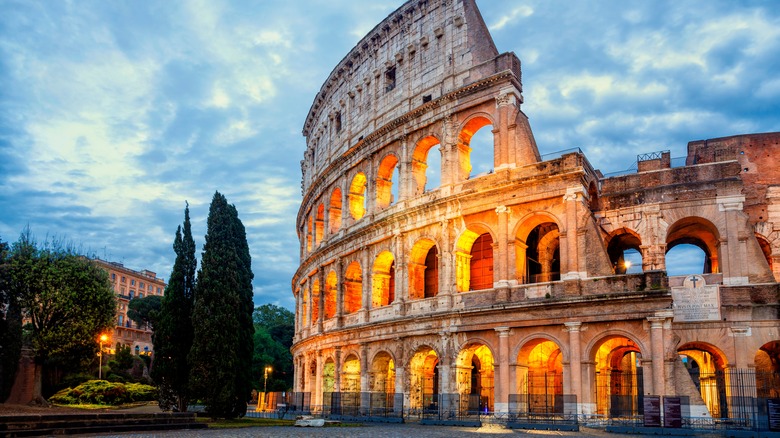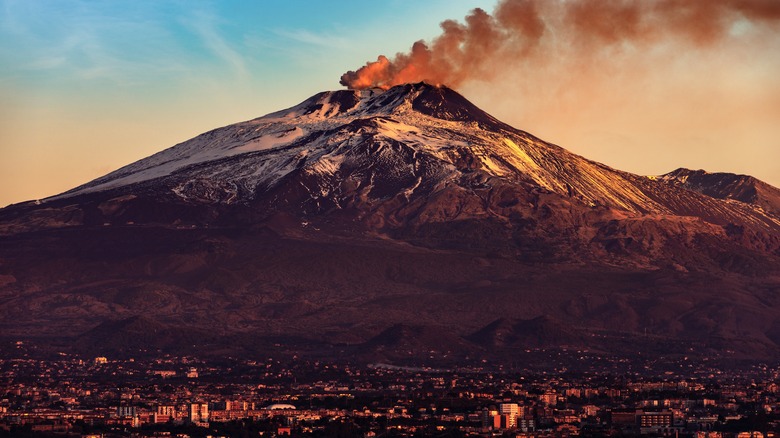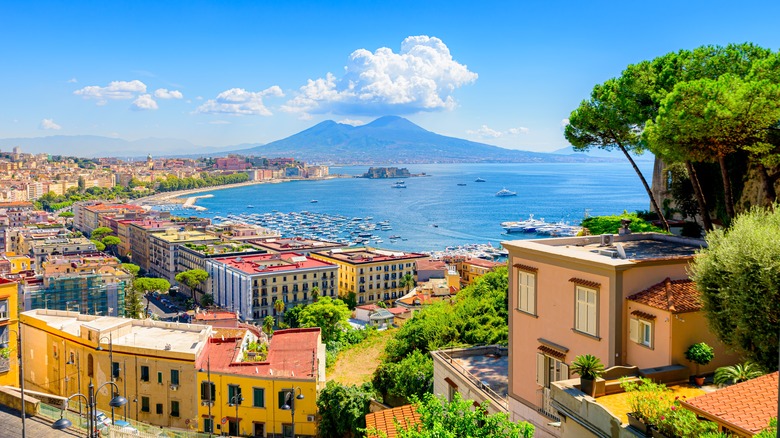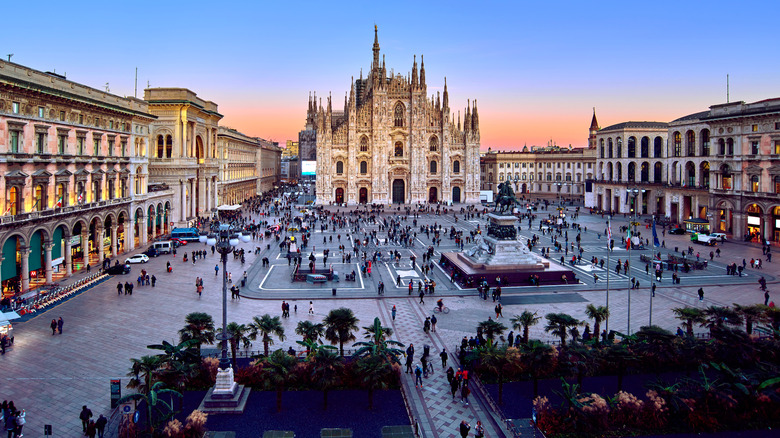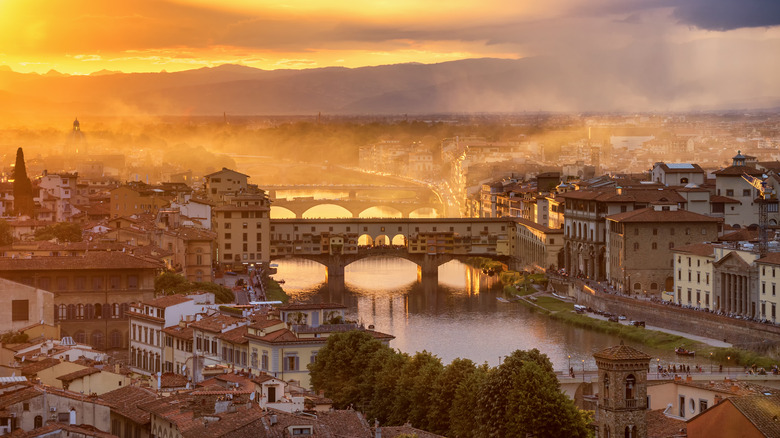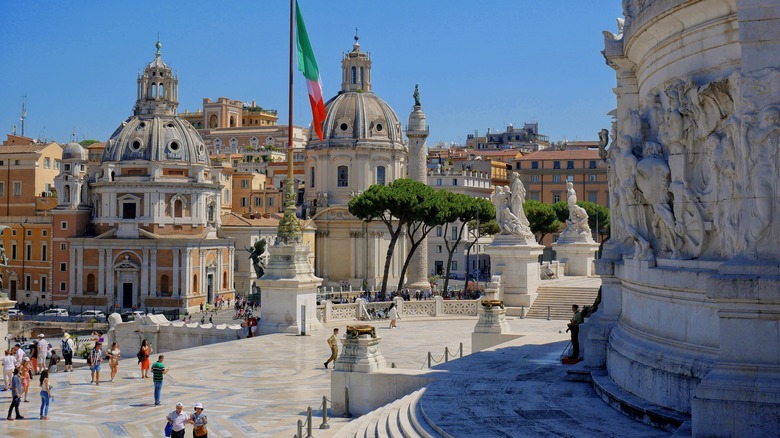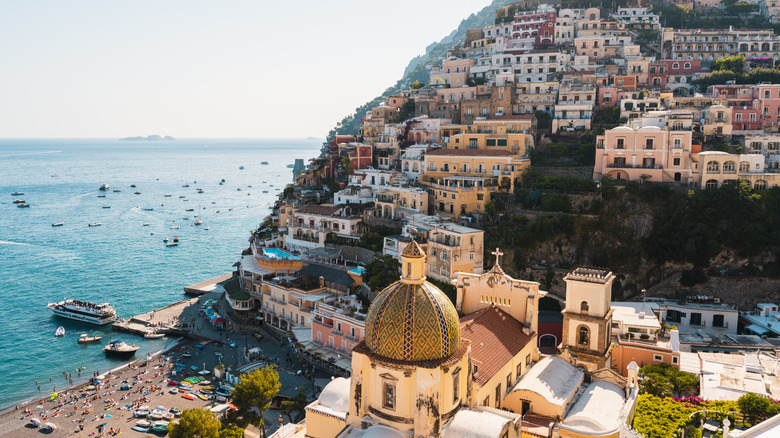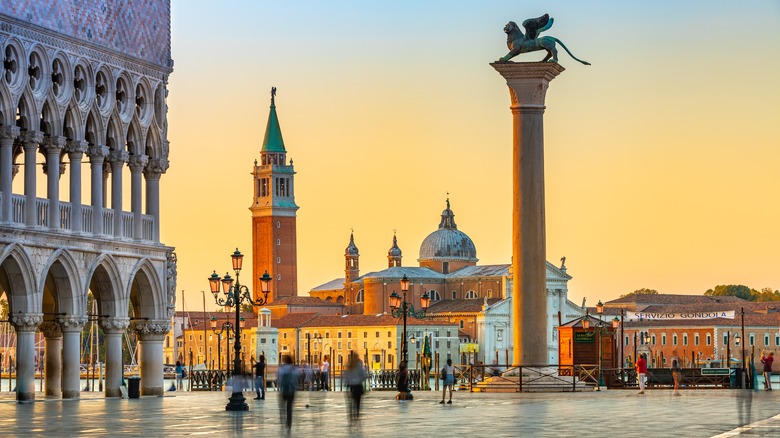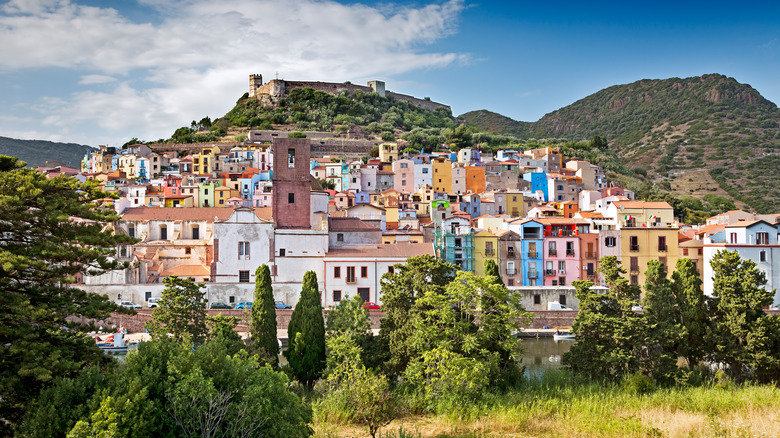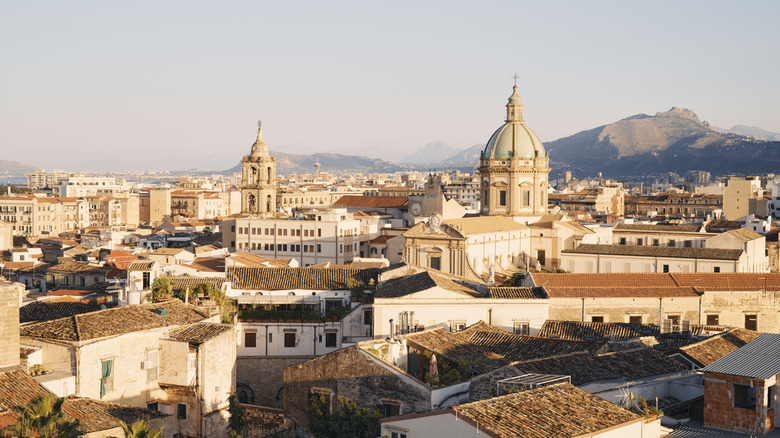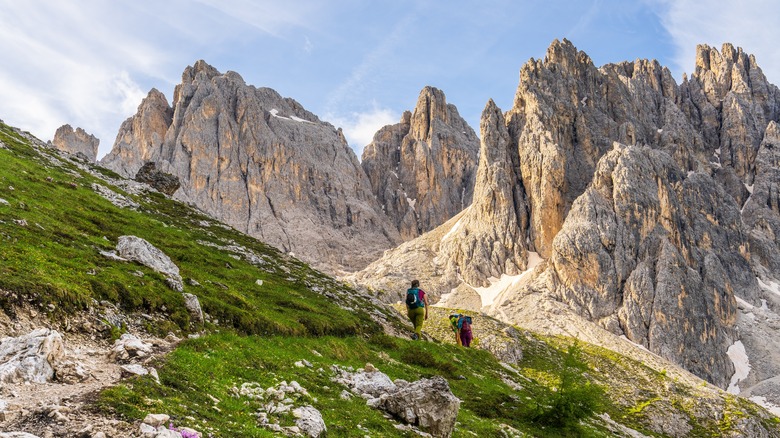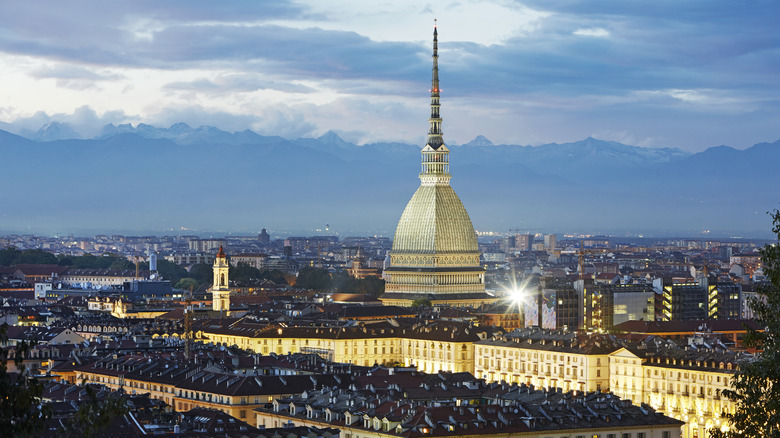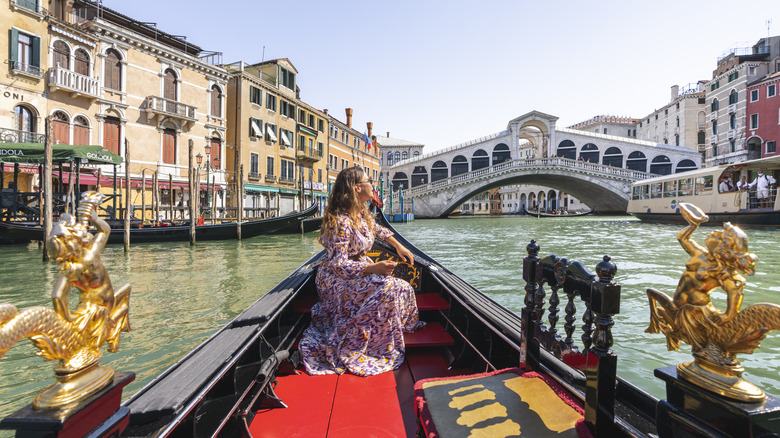The Most Dangerous Vacation Destinations In Italy, According To Research
Whether they choose to wander through the Chianti Hills in Tuscany (Italy's best destination for wine lovers), take in the breathtaking majesty of the northern Alps, or see Rome for the first time, many travelers have included a trip to this Mediterranean country on their bucket lists. With its charm, scenic beauty, and amazing cuisine, the locale ranks among the most-visited European nations for good reason. Yet, as is the case everywhere in the world, some areas in Italy are certainly safer than others.
While we would never suggest that you shouldn't travel to Italy, certain popular vacation destinations within the country pose something of a risk. Though you should always take crime rates and advisories into consideration when traveling, they are not the sole determiner of danger at a given spot. Natural hazards, road conditions, risky hiking trails, and wild animals should also be on the forefront of a traveler's mind. To create our list of Italian destinations with potentially perilous elements, we collected information from several sources, such as news outlets and studies. You'll find a more in-depth explanation of our methodology at the end of this article.
Catania ranks as one of the most dangerous cities in Europe
Catania sits on the eastern side of Sicily, Italy's largest island. Considered one of the most beautiful coastal towns in all of Europe, there are nevertheless some dangers to remain aware of. According to the travel insurance agency Axa Schengen, Catania ranks as one of the continent's most dangerous cities. So, what gives? As with any metro area, the risk level of wandering the streets increases when night falls. Catania sees several petty crimes and the occasional violent assault, but no more so than your average American city, per safety tech company Vigilios. However, the petty crimes pale in comparison to the looming mass that can be seen from every corner of the municipality.
Mt. Etna is one of Italy's nine active volcanoes. It poses a risk to travelers due to its status as "the most active stratovolcano in the world," according to UNESCO. In July 2024, Etna erupted severely, causing Catania's airport to close, and several flights to be delayed. The air quality was considered highly dangerous, and the mayor ordered a halt on cycle and motorcycle traffic owing to the amount of ash circulating. A visit to Catania, while breathtakingly beautiful, comes with the potential for being affected by one of Etna's frequent eruptions.
Naples sits in the shadow of Mt. Vesuvius
Located in southern Italy, Naples has an (unearned) reputation as a dirty and dangerous city. While petty theft is common, organized crime has largely given the locale its less-than-stellar image. Though the Camorra crime syndicate has a strong presence there, it works mainly in the shadows and does not go out of its way to bother tourists, according to Ausra, the travel blogger behind The Road Reel. However, this element is not the most threatening aspect of the destination.
Like Catania, the nearby Mount Vesuvius provides the greatest peril for visitors. This active volcano was responsible for one of the most powerful eruptions in all of human history. In 79 A.D., after centuries of dormancy, Vesuvius erupted with a force rivaling any bomb. Ash clouds and magma covered the ancient city of Pompeii, killing nearly all of its 20,000 inhabitants. The site remains an archeological wonder, though Pompeii is hotly debated as a tourist trap or must-see for Italy vacation itineraries.
Though an eruption of that magnitude has not occurred since, the BBC reports that the increased earthquakes in the area make another significant event possible. While the most recent destructive eruption occurred in 1944, the fact remains that Vesuvius, or another crater hidden below ground, could burst and destroy the surrounding area once again. This prospect shouldn't stop you from visiting Naples, however. The pizza alone is worth the risk of a volcanic explosion.
Milan has the highest crime rate in Italy
Milan is an experience. The capital of Lombardy is filled with tremendous art, like Da Vinci's Last Supper, stunning fashion, delicious food, and gorgeous architecture. Anyone looking for modern cosmopolitan culture mixed with a rich regional history will likely love a trip to Milan. Tourists can feel safe walking around the city day and night, provided that they are in the right neighborhoods.
Outside of the glitz and glamor, there is a side to Milan that is a little more gritty. In fact, Statista listed Milan as the province with the highest crime rate in the country in 2022, with an average of nearly 7,000 felonies per 100,000 residents. Considering Milan's status as the second most populous city in Italy after Rome, that's not a significantly large margin. It remains relatively safe. However, the number is high enough to give travelers pause when considering Milan as a vacation destination.
Thankfully, the majority of Milan's crimes are non-violent. Theft is the biggest concern when it comes to tourists, but if people are aware and well prepared for the possibility, it probably won't be a problem. Nighttime increases the rate of these crimes, so it is not advisable to venture too far outside of the more tourist-filled areas after the sun goes down.
Florence is no stranger to floods
As someone who lived in Florence for the better part of a year in 2015, I can confidently say that I know the city very well. It's one of the safer Italian cities to visit, in my opinion. Locals warned us to watch out for pickpockets and the black taxicabs, but otherwise my friends and I were never accosted by anyone, even in the rougher neighborhoods. Rather, flooding should be your biggest safety concern at this destination.
Walking through Florence, you will notice stone plaques on buildings stamped with the date "1966." These are markers for how high the waters of the Arno River got during a flood that year. As the worst natural disaster ever to befall Florence, the Great Flood left an indelible mark on the city, and is often a topic of conversation among residents.
Sadly, the past few years have threatened to mimic the events of 1966. Deadly flooding in Florence and Tuscany occured in November 2023 as a result of Storm Ciaran. NASA images show just how severe the flooding was in certain areas. So, if you want to avoid the rainy season in Tuscany, aim for a summer trip. It's hotter and more crowded, but the chance of rain is minimal, so you won't have to worry as much about potential floods.
Watch out for cars in Rome
There is something special about Rome, a city that makes a great starting point for your Italian vacation. Perhaps it's the fact that you are a short walk away from some of the most important moments and structures from ancient history. Or maybe it's the romance of the Tiber and the sunsets on the Spanish steps. The allure of Rome brings no shortage of tourists, but you'll need to be careful, especially when crossing the street.
A study conducted by Lumsa University in Rome concluded that there are at least three auto accidents every hour in the city. The data set, reported by Italian Insider, was collected from traffic reports filed between 2019 and 2021. In those years, there were nearly 78,000 accidents, almost 29,000 of which resulted in the injury or death of a driver, passenger, or civilian. In 2023, an Irish couple died in a motoring accident on the city's outskirts — just one example of how serious a problem this can be for visitors.
Granted, Rome was not built for cars. The famous Piazza Venezia alone is a traffic nightmare for outsiders. But with poorly marked one-way streets, limited traffic zones, zig-zagging pedestrians, scooters, and fellow frustrated drivers, you have the perfect recipe for thousands of auto accidents every year. Look both ways, but also up, down, sideways, and 360 degrees before you cross the street in this famous city.
The Amalfi Coast experiences hazardous mudslides
Not that you need more reasons to visit Italy, but the Amalfi Coast deserves a spot on every seaside lover's list of places to go. Defined by its high cliffs, scenic villages, citrus, and stunning beaches, the Amalfi Coast is a picture-perfect vacation destination that millions of people enjoy every year. However, while it has some of the lowest crime rates, there are still some dangers visitors should be aware of along the Amalfi Coast.
For at least a century, the Amalfi Coast has been subject to unrelenting heavy rains that have caused deadly mudslides throughout the region. A 1924 report from the U.K. newspaper The Times noted that a storm destroyed 500 yards of coast, with 60 people dying as a result. More recent reports show that abandoned farm infrastructure and increasing storms have caused additional erosion to the terraced landscape of the Amalfi Coast.
The rainy season along the Amalfi Coast typically lasts from October to February. Early spring is the best time to visit Italy, but that does not mean that a storm or mudslide won't occur. The increased risk from decaying terrace walls and greater amounts of rain should be kept in mind when vacationing on this treasured coast.
Check your pockets in Venice
Tied with Rome as the most iconic of all Italian cities, Venice is an unrivaled experience. How many places in the world can say that they are built atop an ancient infrastructure that has kept the city floating in the same lagoon for over 1,500 years? The curved alleyways, scenic canals, singing gondoliers, humming motorboats, and renowned St. Mark's Square make Venice a truly unique city that should not be missed by anyone.
Yet, it is these very characteristics that make Venice such a hotbed for theft. According to Statista, using data collected in 2022, theft was the most common felony in all of Venice, with around 19,800 cases reported. If that number seems small, consider the fact that the next highest-reported crime was around 4,600 counts of "swindles and cyber frauds." Perspective is everything.
Steps are being taken to curb these crimes, however. While the city has increased its police presence, everyday Venetians are taking to vigilantism to stop pickpockets. During an April 2024 occurrence, one of Venice's anti-pickpocket crusaders was attacked by thieves. So, while there have been efforts to lower the number of thefts in the city, visitors should still be wary of their belongings when in Venice.
Sardinia wildfires are common in the summer
Known as a budget-friendly, warm-weather European island, Sardinia sits somewhat apart from mainland Italy both physically and culturally. Aspects of Sardinia are so wholly unique to the area that it could well be considered its own micro country. The cuisine alone is worth a visit: With delectable seafood, delicious pastas, and a maggot-infested cheese that only the bravest of tourists will eat, there is so much to explore in Sardinia. Nature, however, has made this increasingly difficult.
In recent years, wildfires have been an immense problem for this scenic island. According to The New York Times, owing to high summer temperatures and very little in the way of rainfall, the island experiences wildfires every year. Not only does this affect the tourists due to air quality and safety concerns, but it also impacts the native Sardinians who make their life in the mountains and hills of the island.
Footage taken by Reuters shows the extent of the damage from the wildfires that occurred in 2023. The flames spread across fields and cities with no discrimination for tourists and locals. Given this, a trip to Sardinia might be better in the quieter winter, spring, or fall. Yes, summer yields the best beach weather, but the increased risk of wildfires might make you think twice before heading to Sardinia in peak season.
The mafia is present, but dwindling, in Palermo
The capital of Sicily, Palermo is a great coastal city with plenty to offer in terms of scenery, food, and history. The architecture alone is enough to make even the most ardent modernist step back in wonder. And lest you think Sicily is only about pasta and cannoli, the food you can find in Palermo is a mix of cuisines from other Mediterranean countries, including influences from North Africa. It's a wonderfully diverse place to visit, but there is an underlying problem that continues to haunt the area.
While many tourists tend to view the Sicilian Mafia, or Cosa Nostra, through a Hollywood lens, the fact of the matter is that it is a very real thing in Sicily. As the capital, Palermo has historically been the center of Sicilian Mafia activity. There were several decades in the late 20th century when it was dangerous for anyone, even locals, to be in Palermo. However, the influence of the Mafia has dwindled significantly thanks, in part, to a massive student movement.
Yet, this does not mean it has vanished. According to Bloomberg, the Mafia has centered its efforts more on white collar crimes, like phony invoicing apps, as opposed to its traditional brands of violent tactics. While visitors aren't likely to be affected, the crime impacts thousands of Sicilians. Travelers would do well to remain aware of the disparity this causes.
Be careful when hiking Italy's Dolomites
The Dolomites are a mountaineer's dream. Composed of tall, scraggly peaks that seem to stretch to infinity, the iconic mountain range in northern Italy blends traditional Italian culture with those of the Swiss and Austrians. The mountains and meadows of this region are among the most beautiful in all of Europe. The area also offers some of the best Alpine hiking you're likely to find outside of Austria. Still, there are reasons to be careful.
Thanks to the steepness and lack of maintenance on certain trails, less experienced climbers may have a tough time accessing the region. One such climb is the Via Ferrata tour, which should really only be attempted by seasoned mountain climbers. While the views are absolutely incredible, the difficulty of the near vertical climb along the rocks should only ever be attempted by those who know what they are doing. A hiker died there in 2024, with another falling to their death in a separate part of the Dolomites in 2022, just to name a couple of fatal incidents that have occured in the region.
Luckily, there are plenty of meadows and farmsteads for regular tourists to visit. According to "Rick Steves' Europe," a drive or bike-ride up to the 7,000 foot Sella Pass is one of the safest and most efficient ways to get a glimpse of the Dolomites in all of their rocky glory.
Turin is beautiful, but has high crime
Finally, we have Turin. One of the most iconic cities in the world, thanks in part to the famous shroud that is said to be stamped with an outline of Jesus Christ immediately following the crucifixion, Turin is something of a hotbed for tourists looking to get a taste of Northern Italy without the massive crowds so common in Milan. Thanks to the influx of travelers, Turin is relatively safe, though it still comes in as an area of high crime.
Turin ranks just behind Florence with around 5,000 crimes per 100,000 people in 2022, according to Statista. Redbook.cc lists petty theft, drug use, and pickpocketing as common in Turin, especially at night. Visitors would do well to stick to the well-lit, tourist centered areas that are consistently patrolled by law enforcement. Sticking to these zones makes it less statistically likely that visitors will fall victim to any sort of crime.
Methodology
We put this list together using primary sources, such as news articles, research done by universities and insurance companies, personal accounts, and statistical analysis groups. Rather than focusing solely on crime rates, we made sure to include a spread of potentially dangerous elements that even more frequent travelers might not have thought to keep an eye out for.
As stated previously, don't let the fact that danger is present in all of these places stop you from visiting Italy. Overall, it is a very safe country that has attracted millions of people from all over the world. If you do head to any of these vacation destinations, just keep travel safety best practices (like Rick Steves' expert tips to avoid to avoid getting pickpocketed in Europe) in mind to have the most secure trip possible.
